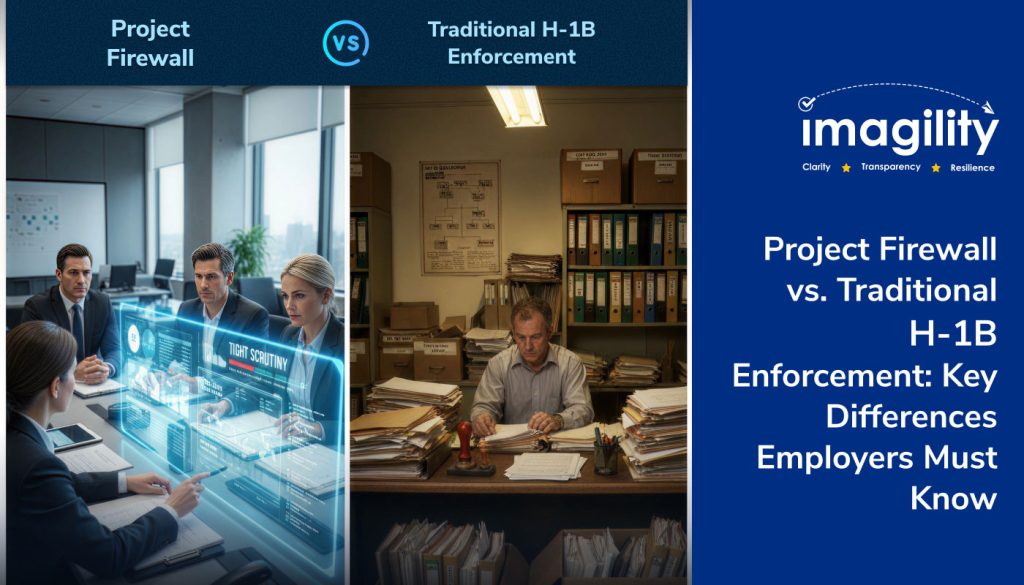Earlier, most employers viewed H-1B compliance as a routine task, involving completing paperwork, maintaining records, and documenting wages. Enforcement from the U.S. The Department of Labor (DOL) was largely reactive, often triggered only when an employee filed a complaint or an irregularity was flagged during a review.
That landscape shifted on 19 September 2025 with the launch of Project Firewall. Unlike past enforcement approaches, this initiative equips the DOL with tools to monitor employers proactively, share data across agencies, and levy much steeper penalties.
To understand the significance of this shift, let’s look at how Project Firewall compares with traditional enforcement models, and why this matters for businesses that rely on skilled foreign talent.
From Complaints to Continuous Oversight
In the past, the DOL’s investigations were usually sparked by something external, a worker complaint, a whistleblower tip, or an obvious red flag. Routine audits did exist but were infrequent and rarely covered the full scope of an employer’s compliance obligations.
Project Firewall reverses the old approach. The DOL can now launch investigations without any complaint. Payroll mismatches, media stories, or data inconsistencies can all serve as triggers. In other words, employers can find themselves under review even if no one has raised an issue internally.
Takeaway: Employers must assume they are always “audit-ready.” Compliance can no longer wait until after a problem surfaces.
Data Sharing and Interagency Collaboration
Historically, each agency operated in silos. The DOL checked labor condition applications (LCAs), while USCIS focused on petitions. Information rarely moved seamlessly between systems, which meant enforcement gaps often went unaddressed.
Project Firewall is designed to close those gaps. Now, agencies such as the DOL, USCIS, DOJ, EEOC, and SSA can share data in real time. Payroll reports, immigration petitions, LCAs, and even I-9 forms are compared for consistency.
Takeaway: A small mistake in payroll records can now trigger broader reviews involving multiple agencies, exposing employers to overlapping risks.
Penalties with Real Consequences
In the past, the financial fallout from violations was manageable for many employers. Back wage payments and moderate fines were the norm, and debarment from the H-1B program was relatively rare.
Project Firewall raises the stakes dramatically. Employers may now face:
- Civil penalties of $2,500–$25,000 per violation
- Mandatory back wages plus interest
- Debarment from the H-1B program for up to three years
- Criminal referrals in cases involving fraud
Takeaway: For large companies and staffing firms with hundreds of H-1B employees, noncompliance could lead to multimillion-dollar penalties or the loss of access to H-1B talent altogether.
Spotlight on Staffing and Third-Party Placements
Traditional enforcement was focused primarily on wages and LCA filings. Oversight of staffing companies and third-party worksite placements was inconsistent.
Project Firewall makes staffing firms and IT service providers a priority focus. The DOL is expected to closely examine client letters, LCA coverage for each assignment, and proof of worksite postings. Remote and hybrid work arrangements are also drawing increased scrutiny.
Takeaway: Staffing firms face the greatest exposure. Every placement must be carefully documented to avoid compliance gaps.
Compliance as an Ongoing Strategy
Perhaps the biggest cultural shift under Project Firewall is that compliance is no longer something employers can treat as a one-off task during filing season.
Now, compliance must be integrated into daily operations. Public Access Files (PAFs), payroll, LCAs, and I-9s must always be current and accurate. HR and legal teams need ongoing training, internal audits, and reliable monitoring systems.
Takeaway: Companies that treat compliance as a strategic priority will be best positioned to manage risk and protect their access to the H-1B program.
Project Firewall Employer Risk Self-Assessment Checklist
To evaluate your readiness, consider the following:
- Are your Public Access Files (PAFs) complete and immediately audit-ready?
- Do payroll records match up with prevailing wage obligations in LCAs?
- Are postings and client letters properly documented for every third-party placement?
- Have I-9s and immigration filings been cross-checked for accuracy?
- Do your HR and compliance teams receive regular training?
- Is there a system in place to track and monitor compliance risks in real time?
If you answered “no” to any of these, your organization may be at higher risk under Project Firewall.
Conclusion
Project Firewall represents a turning point in H-1B enforcement. It is proactive, data-driven, and unforgiving when it comes to penalties. Employers can no longer assume that audits only happen when something goes wrong. To stay compliant, U.S. companies must:
- Treat compliance as a continuous process
- Maintain documentation that is always audit-ready
- Invest in proactive monitoring and internal audits
At Imagility, we help employers, staffing firms, and law firms stay ahead of Project Firewall with:
- Audit and compliance readiness services
- Real-time monitoring tools
- An AI-powered platform that centralizes immigration compliance
Schedule a compliance audit with us today to ensure your organization is ready for Project Firewall.










